Climate Change Plan: monitoring report 2019
Second annual report monitoring progress towards Scotland's 2018 Climate Change Plan.
Buildings
Greenhouse gas emissions from the buildings sector have already been reduced by 16% (1990 to 2017).
The Plan sets out the following four policy outcomes for the sector:
1. By 2032, the energy intensity of Scotland’s residential buildings will fall by 30% on 2015 levels.
2. By 2032, the emissions intensity of residential buildings will fall by at least 30% on 2015 levels.
3. By 2032, non-domestic energy productivity to improve by at least 30% on 2015 levels.
4. By 2032, the emissions intensity of the non-domestic sector will fall by at least 30% on 2015 levels.
The long-term trend shows that the emissions intensity of Scotland’s residential buildings has fallen by 34% between 1998-2017, while energy intensity in the residential sector has fallen by 26% between 2005 and 2017. The energy productivity of the non-domestic (services) sector is falling, as energy consumption starts to increase. Emissions intensity has fallen by 34% between 1998 and 2017.
The Energy Efficient Scotland Route Map was published in May 2018. By 2040, Energy Efficient Scotland will have transformed our buildings so that they are warmer, greener and more efficient and we are putting in place a framework of standards to make it the norm to invest in energy efficiency.
We have recently consulted on whether Energy Efficient Scotland could be accelerated and how this could be achieved in line with a Just Transition and responses are being analysed. We will consider the responses with our partners in local government, and will publish an analysis report on the consultation by the end of the year.
Further details will be provided next year around the assessment of properties under Energy Efficient Scotland, the implementation of recommendations concerning quality assurance and skills and supply chain and the delivery mechanism.
Existing Home Energy Efficiency Programmes will continue under Energy Efficient Scotland and further details of our offers of support to the owner occupied sector will also be outlined next year.
Output Indicator For Policy Outcome 1:
Change in energy intensity of residential buildings from 2015.
| 2020 | 2025 | 2032 | |
|---|---|---|---|
| Change in energy intensity from 2015 | -10% | -17% | -30% |
Most Recent Data: 18.2 MWh per household in 2017.
Baseline Data: 18.3 MWh per household in 2015.
Change: 0.9% reduction in energy intensity between 2015 and 2017.
Data Source(s): Scottish Government Energy Statistics Database[1].
On Track: Too early to make assessment as latest data available is for 2017.
Commentary:
Buildings Figure 1: Relative Changes in Energy Intensity of Residential buildings (MWh per household), 2015 to 2017 (2015=100)
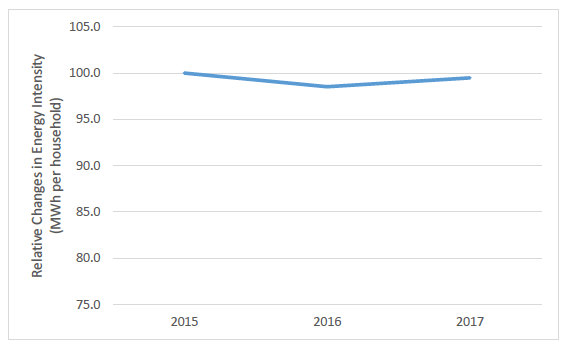
Energy intensity of residential buildings has fallen 0.9% between 2015 and 2017. It has fallen by 23.7% since the first available consumption data in 2005. This decrease over time is due to both a general trend of decreasing energy consumption and increasing household
Output Indicator For Policy Outcome 2:
Change in emissions intensity of residential buildings from 2015.
| 2020 | 2025 | 2032 | |
|---|---|---|---|
| Change in emissions intensity from 2015 | -5% | -13% | -30% |
Most Recent Data: 2.45 tCO2e per household in 2017.
Baseline Data: 2.51 tCO2e per household in 2015.
Change: 2.1% decrease in emissions intensity between 2015 and 2017.
Data Source(s): Scottish Greenhouse Gas Emissions (Scottish Government)[2]; Estimates of households and dwellings in Scotland, 2018 (NRS)[3].
On Track: Too early to make assessment as latest data available is for 2017.
Commentary:
Buildings Figure 2: Relative Changes in Emissions Intensity of Residential buildings (tCO2e per household), 2015 to 2017 (2015=100)
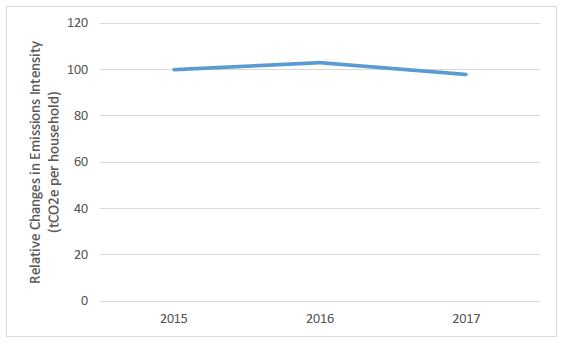
Between 2015 and 2017 emissions intensity in the residential sector fell by 2.1%. Although it varies annually, mainly driven by fluctuating external temperatures, residential emissions intensity has fallen 34% between 1998 and 2017.
Output Indicator For Policy Outcome 3:
Change in non-domestic (services) energy productivity from 2015.
| 2020 | 2025 | 2032 | |
|---|---|---|---|
| Change in energy productivity from 2015 | 10% | 20% | 30% |
Most Recent Data: £3.37 million Gross Value Added (GVA) per GWh in 2017.
Baseline Data: £3.38 million GVA per GWh in 2015.
Change: £0.01 million GVA per GWh reduction in energy productivity from 2015 to 2017.
Data Source(s): Scottish Government Energy Statistics Database[1].
On Track: Too early to make assessment as latest data available is for 2017.
Commentary:
Buildings Figure 3: Relative Changes in Energy Productivity (GVA/GWh), 2005 to 2017 (2015=100)
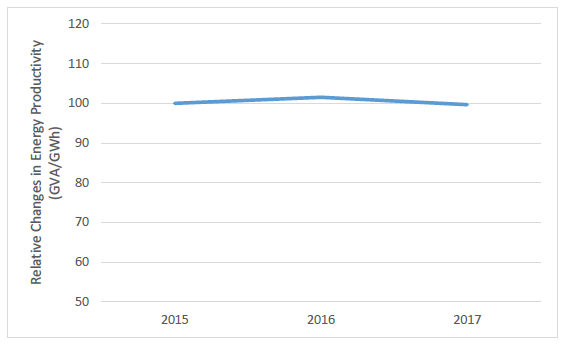
Energy productivity in the services sector increased by 1.5% between 2015 and 2016, and then decreased by 1.8% between 2016 and 2017. Even though GVA in the services sector increased by 0.8% between 2016 and 2017, consumption increased by 2.6%, hence the decrease in productivity.
Output Indicator For Policy Outcome 4:
Change in emissions intensity of non-domestic sector from 2015.
| 2020 | 2025 | 2032 | |
|---|---|---|---|
| Change in emissions intensity from 2015 | -10% | -20% | -30% |
Most Recent Data: 36.2 million tonnes of CO2e per £million GVA in 2017.
Baseline Data: 38.2 MtCO2e per £million GVA in 2015.
Change: 5.2% reduction in emissions intensity from 2015 to 2017.
Data Source(s): Scottish Government Energy Statistics Database[1].
On Track: Too early to make assessment as latest available data is for 2017.
Commentary:
Buildings Figure 4: Relative Changes in Emissions Intensity (tCO2e/£ millions), 2015-2017, (2015=100)
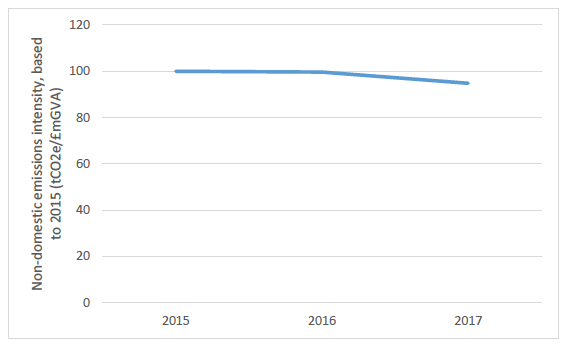
Emissions intensity fell by 5.2% between 2015 and 2017. Between 1998 and 2017 emissions intensity fell by 34%, as a result of an underlying 7% fall in emissions and a 41% increase in GVA (2016
Implementation Indicator For Policy Outcomes 1, 2, 3 And 4:
Average energy efficiency levels of domestic buildings increases.
Most Recent Data: Average energy efficiency rating (SAP 2012) of 64.3 in 2017.
Baseline Data: Average energy efficiency rating (SAP 2012) of 62.8 in 2015.
Change: +1.5 SAP points between 2015 and 2017.
Data Source(s): Scottish House Condition Survey[4].
Energy efficiency ratings are calculated under two versions of Standard Assessment Procedure (SAP), the SAP 2009 methodology and the most recent SAP 2012 methodology. Using SAP 2009 enables us to examine the trend in the energy efficiency of the housing stock since 2010. SAP 2012 was first used in reporting data from the Scottish House Condition Survey in the 2014 Key Findings Report and therefore only four years of data are available.
Commentary:
An increase in the average energy efficiency of domestic buildings will contribute to reducing energy intensity and emissions intensity in the residential sector.
We are able to explore long-term improvements in the average energy efficiency of the Scottish housing stock using SAP 2009. Over the period 2010 to 2017, the average energy efficiency rating increased from 59.9 to 65.6. This highlights that Scottish housing is gradually moving up through the Energy Performance Certificate bands.
The data presented for this indicator are the mean energy efficiency rating. The median rating in 2017 was 67 (SAP 2012) indicating that half of the housing stock has an energy efficiency rating of 67 or better. Based on SAP 2009, we can also see that the median rating has improved over time, increasing from 62 in 2010 to 68 in 2017.
Implementation Indicator For Policy Outcomes 1, 2, 3 And 4:
Grouped domestic energy efficiency ratings improve.
Most Recent Data: 42% of dwellings rated as EPC band C (SAP 2012) or better in 2017.
Baseline Data: 37% of dwellings rated as EPC band C (SAP 2012) or better in 2015.
Change: 6 percentage point increase between 2015 and 2017 in the percentage of dwellings rated as EPC band C or better.
Data Source(s): Scottish House Condition Survey[4].
Commentary:
Buildings Figure 5: Grouped EPC Bands under SAP 2009 and SAP 2012, 2010-2017
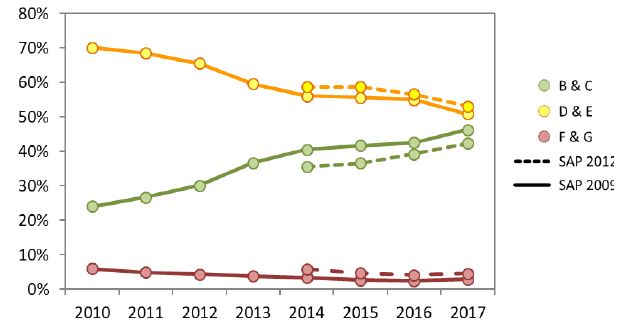
There has been a statistically significant increase in the proportion of homes whose EPC rating is at least band C from the 2015 baseline.
The Figure shows a strong trend of improvement in the energy efficiency profile of the housing stock since 2010. The proportion of dwellings rated C or better increased from 24% in 2010 to 46% in 2017 (as measured under SAP 2009), and 35% in 2014 to 42% in 2017 (as measured under SAP 2012).
An improvement in the energy efficiency profile of the domestic building stock will contribute to reducing energy intensity and emissions intensity in the residential sector.
Implementation Indicator For Policy Outcomes 1, 2, 3 And 4:
Percentage of domestic properties with loft and wall insulation increases.
Most Recent Data: 63% of lofts had at least 200mm of loft insulation while 60% of dwellings had wall insulation (cavity or solid) in 2017.
Baseline Data: 64% of lofts had at least 200mm of loft insulation while 56% of dwellings had wall insulation (cavity or solid) in 2015.
Change: No statistically significant difference in the proportion of lofts that had at least 200mm of loft insulation between 2015 and 2017. There is a statistically significant increase in the proportion of dwellings that have solid or cavity wall insulation from 2015 to 2017.
Data Source(s): Scottish House Condition Survey[4].
Commentary:
Buildings Figure 6: Depth of Loft Insulation (where applicable) 2003/2004 -2017
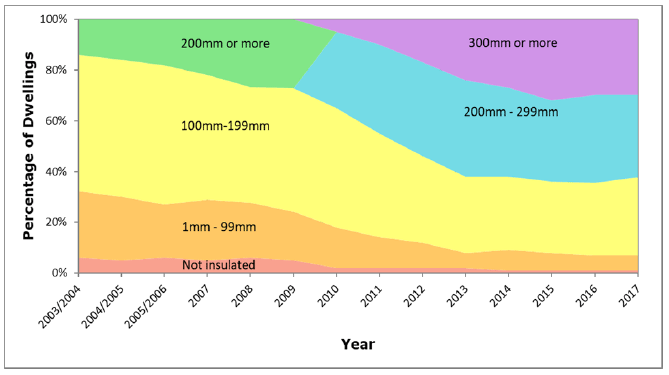
An increase in insulation levels will contribute to reducing energy and emissions intensity in the residential sector. Existing HEEPS Area Based Schemes and Warmer Homes Scotland continue to fund and support insulation measures including solid wall insulation contributing to reduced energy demand and emissions in the domestic sector.
Implementation Indicator For Policy Outcomes 1, 2, 3 And 4:
Total renewable heat generation in Scotland increases.
Most Recent Data: 4,569 GWh renewable heat generated in 2017.
Baseline Data: 4,205 GWh renewable heat generated in 2015.
Change: 364 GWh (8.7%) increase in renewable heat generated from 2015 to 2017.
Data Source(s): Scottish Government Energy Statistics Database[1].
Commentary:
Buildings Figure 7: Renewable Heat Generation (GWh) - 2010 to 2017
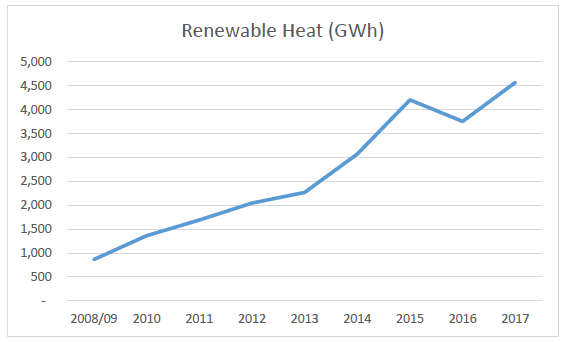
Renewable heat output decreased from 4,205 GWh in 2015 to 3,753 GWh in 2016, and this was attributed to changes at a small number of large sites. Between 2016 and 2017, renewable heat output rose to its highest level to date, 4,569 GWh. This is due to increased generation from existing large commercial sites.
Biomass continues to dominate renewable heat generation; with 74% of all renewable heat from biomass primary combustion and biomass combined heat and power. In 2016 and 2017 growth in primary combustion was higher than growth in CHP.
An increase in the level of renewable heat generation will contribute to reducing the carbon intensity of Scotland’s heat generation in both the domestic and non-domestic sector.
Implementation Indicator For Policy Outcomes 1, 2, 3 And 4:
Installed capacity of non-domestic Renewable Heat Incentive (RHI) increases.
Most Recent Data: 985 MW of accredited capacity under the non-domestic RHI between November 2011 and August 2019.
Baseline Data: 250 MW of accredited capacity under the non-domestic RHI between November 2011 and February 2015.
Change: There was an additional 735 MW of accredited capacity of renewable heat receiving payment under the non-domestic RHI between February 2015 and August 2019. It increased by 92 MW between August 2018 and August 2019.
Data Source(s): BEIS Renewable Heat Incentive statistics[5].
Commentary:
Capacity of accredited non-domestic RHI installations have steadily increased from February 2015. Capacity has almost quadrupled from this period to August 2019. There are 3,753 accredited full applications by August 2019.
Implementation Indicator For Policy Outcomes 1, 2, 3 And 4:
Amount of renewable heat paid for under the domestic RHI scheme in Scotland increases.
Most Recent Data: 872 GWh of heat had been paid for between April 2014 and end June 2019 under the domestic RHI scheme in Scotland.
Baseline Data: Between April 2014 and end September 2016 around 276 GWh of heat had been paid for under the domestic RHI scheme in Scotland.
Change: An additional 596 GWh of renewable heat was paid for between October 2016 and June 2019.
Data Source(s): Scottish Government Energy Statistics Database[1].
Commentary: Two thirds of all heat generated and paid for under the domestic RHI scheme from April 2014 to June 2019 was from biomass systems, with air source heat pumps making up a quarter of heat generated.
Implementation Indicator For Policy Outcomes 1, 2, 3 And 4:
Further analysis to establish a baseline for non-domestic buildings’ energy efficiency and emissions data.
Baseline Data: It is estimated that almost three in four of all non-domestic premises have a current EPC band of E or worse with 5 percent banded B or better.
Source: Scotland's non-domestic energy efficiency baseline, Scottish
Government[6].
Commentary:
Buildings Figure 8: Non-domestic premises by current EPC band
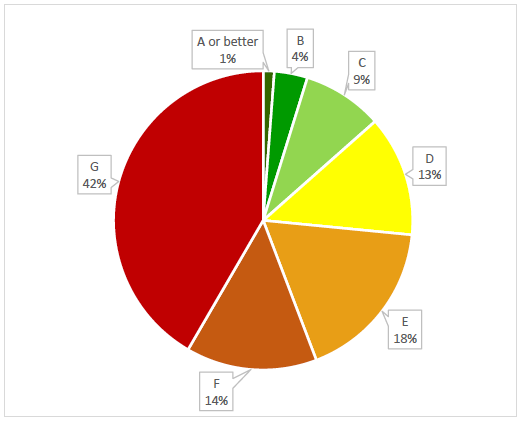
EPC bands present the calculated greenhouse gas emissions for buildings on a scale from A to G. The underlying rating therefore reflects the energy efficiency of building elements (e.g. building fabric), the types of fuel used and heating,
lighting and ventilation demand standardised by a combination of building type and activity.
Contact
Email: climate.change@gov.scot
There is a problem
Thanks for your feedback